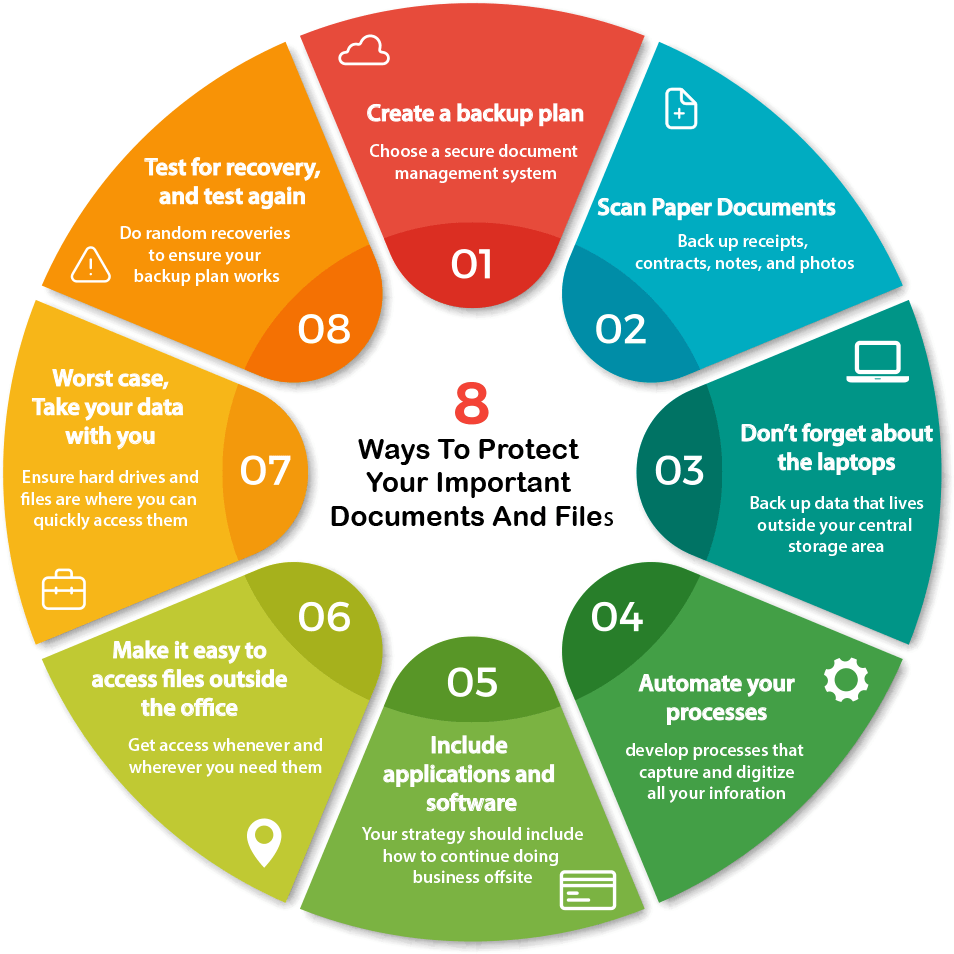
8 Ways To Protect Your Important Documents And Files
We often tell ourselves, “that will never happen to me!” But the recent string of hurricanes and disasters prove otherwise. They are a powerful reminder of how easily our documents and data can be upset or destroyed, having a severe impact on our businesses. You don’t want to find yourself saying “If I had only been more prepared.” That said, this is a good time to reiterate the importance of securing your important data, documents, and photos, and highlight how technology can help you do just that.
It doesn’t take a hurricane to destroy your records. It can be a fire, broken pipe, flood, or even vandalism. You can also lose important records when someone removes the wrong file or pushes delete too soon. But you can take steps today to protect your important documents, contracts, medical records, legal files, or precious photos from catastrophic loss. Here are 8 things you can do immediately.
- Create a backup plan: It is scary how many organizations still manage their business on paper. This is an indication that information is not securely stored and they don’t have a backup plan to get their business back up and running after a disaster occurs. The first step in a backup plan is choosing a secure document management system. Your files should be backed up at least daily, and the backup should be maintained off site or preferably in the cloud. Having redundant backups is also important, minimizing the risk of a total loss.
- Your paper files are data. Scan them and back them up. Paper notes, receipts, contracts, and files with signatures are valid reasons to continue using paper. But paper is easy to destroy and difficult to recreate. Whether it is a fire, flood, or data breach, disaster recovery is far less likely without having your data securely recorded and backed up. Modern document management systems make it easy to scan your files and make digital copies. If you choose a data management system that allows you to attach meta-information that makes searching and finding information quick and painless. Don’t just convert your paper mess into a digital mess. Choose a system that will allow you to quickly find your important information. If you backup your paper files, you can rest easy knowing that, even if you are forced to evacuate, your files are safely available wherever you are and easily recovered when you’re back in the office.
- Don’t forget about the laptops. Most backup plans focus on protecting the center of your data. This location may contain the majority of your files, and even the most important files, but the central storage location almost never contains all the files. According to Gartner research, almost two-thirds of corporate data lives outside our central storage area. The best example of data residing outside of central storage is laptops. Laptops are less resilient than servers and they are more likely to be stolen or even lost. When establishing a backup plan, include laptops and establish a process for regular laptop backup.
- Automate your processes. Do your processes include a paper trail used for recording activity and communicate information to your colleagues in the office? Develop processes that quickly digitize information and make it accessible to everyone in your network. Paper is a great way to capture information. It doesn’t require training or special equipment. Paper can often be the most efficient data collection tool available. But the data is not secure or available for multiple people to access. When choosing a data management system, consider how you will capture important information contained on your paper documents and files. Automate your processes with the most efficient and cost effective data collection available. Once the data is collected, it can quickly and easily be digitized and secured.
- Include applications and software in your backup plan. Depending on your business, protecting your important data isn’t enough. If you want to ensure your business can continue to operate, even when faced with disaster, make sure you have access to critical applications and software. Your backup plan should include a strategy for continuing to do business offsite or in alternate locations.
- Make it easy to access the files outside the office. Having a backup is a good start. But you need to have quick access to your files whenever and wherever you need them. Cloud-based storage will secure your files and allow you to access them from any web enabled device. The last thing you want is a file that is backed up, but inaccessible.
- In the worst case, take your data with you. If there are no other options and in the situation when you don’t have your data backed up, take your data with you. If a cloud-based backup plan is not in place, make sure your data can be easily transported if necessary. Make sure your hard drive or files are where they can be quickly accessed and move to a safe location. This is not the best option. But sometimes keeping the data with you is the only option available.
- Test for recovery — and test again. We’ve all heard the quote, “even the best laid plans of mice and men often go awry.” All the backups in the world cannot save you if you cannot test your backup. It is a good idea to test then test some more. Do random recoveries to ensure your backup plan works. Always be sure you can recover your data.
Our thoughts continue to go out to all those affected by the recent natural disasters. if you have any questions about how you can set up a document management system or establish a backup plan, please contact XTIRI. It’s more than process optimization and efficiency, XTIRI keeps your business prepared for the unexpected. Find out how to keep your corporate information safe and secure at XTIRI.com.









